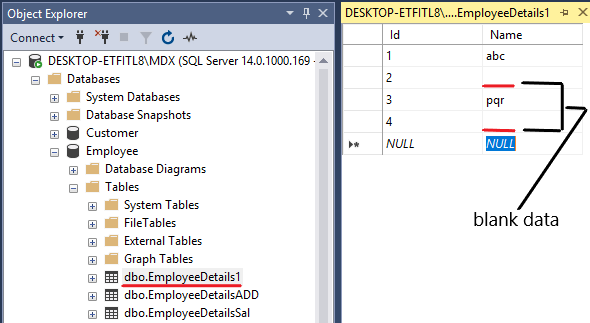Describe the Use of Cursers in Sql Server
Also we cant skip the rows or jump to rows in the query result. Describe how to use Linked Server.

Cursors In Sql Server What Is Cursor By Arjun Sharma Medium
15 rows Use sp_describe_cursor for a description of the global attributes of the server cursor.

. DESCRIBE means to show the information in detail. To obtain a report of the Transact-SQL server cursors that are visible on the connection use sp_cursor_list. MS SQL Server supports the connection to different OLE DB on an ad hoc basis.
Avoiding cursors allows SQL Server to more fully optimize the performance of the query very important in larger systems. Transact-SQL cursors are based on the DECLARE CURSOR syntax and used mainly in Transact-SQL scripts stored procedures and triggers. The Cursor is the PLSQL construct that allows the user to name the work area and access the stored information in it.
These Cursors are allocated by SQL SERVER when the user performs DML operations. This persistent connection is referred as Linked Server. Cursor consumes network resources by requiring a network roundtrip each time it fetches a record.
Transact-SQL cursors are implemented on the server and are managed by Transact-SQL statements sent from the client to the server. SQL Server supports three cursor implementations. For a description of the global characteristics of the cursor such as its scrollability and updatability use sp_describe_cursor.
SQL Server does not have any command to display the table structure like Oracle or MySQL provides DESCRIBE or DESC. When we use a cursor we cant access the data in reverse order as random access is under the check of the controller. I refer this to use an MS-Excel workbook.
Cursors do have their place however I think its mainly because they are often used when a single select statement would suffice to provide aggregation and filtering of results. Hence it is mandatory to understand the cursor types and its functions so that you can use suitable cursor according to your needs. Use sp_describe_cursor_tables for a report of the base tables referenced by the cursor.
A cursor has some limitations so that it should always use only when there is no option except the cursor. DECLARE CURSOR defines the attributes of a Transact-SQL server cursor such as its scrolling behavior and the query used to build the result set on which the cursor operates. The SQL cursor is non-scrollable ie we can traverse only in one direction.
It acts as a loop just like the looping mechanism found in any other programming language like C VBNet C C Java and etc. These are explained as following below. SQL Server Describe Table.
Use sp_describe_cursor_tables for a report of the base tables referenced by the cursor. Also we dont have the freedom to jump to specific result sets in the query output. The following are the steps to use Linked Server for any OLE DB.
Azure Data Warehouse does not support server side cursors for example. However sometimes you may want to process a data set on a row by row basis. The purpose of FETCH is to actually retrieve a single record and load it into the cursor.
The purpose for the cursor may be to update one row at a time or perform an administrative process such as SQL Server database backups in a sequential manner. Implicit Cursors and Explicit Cursors. There are 2 types of Cursors.
Use of Cursor The major function of a cursor is to retrieve data one row at a time from a result set unlike the SQL commands which operate on all the rows in the result set at one time. Open SQL Server Management Studio in SQL Server 2005 2. A DECLARE CURSOR statement may request a cursor type that SQL Server cannot support using the SELECT statement that is contained in the DECLARE CURSOR.
To obtain a report of the Transact-SQL server cursors visible on the connection use sp_cursor_list. When using a driver such as the Microsoft SQL Server JDBC driver or jTDS JDBC driver to connect to Azure Data Warehouse the driver needs to be configured to not use. We can use cursors when we want to do data manipulation operations like update delete and etc on a SQL Server database table in a singleton fashion in other words row by row.
To obtain a report of the Transact-SQL server cursors visible on the connection use sp_cursor_list. A SQL Server cursor is a set of T-SQL logic to loop over a predetermined number of rows one at a time. Implicit Cursors are also known as Default Cursors of SQL SERVER.
The OPEN statement populates the. In this tutorial you will learn how to use the SQL Server cursor to process a result set one row at a time. Requires membership in the public role.
For a description of the attributes of the result set returned by the cursor use sp_describe_cursor_columns. A Cursor impacts the performance of the SQL Server since it uses the SQL Server instances memory reduce concurrency decrease network bandwidth and lock resources. SQL works based on set eg SELECT statement returns a set of rows which is called a result set.
Since we have several tables in our SQL Server database we will need a command to show a tables structure such as column names data types constraints on column names etc. Cursors are used to store Database Tables. A cursor is a memory resident set of pointers which means it takes some memory that.
You should avoid the use of the cursor. In later examples SQL Server Memory. SQL Server cursors are database The DECLARE CURSOR command defines the attributes of a Transact-SQL server cursor For example after declaring a cursor Cursors with SQL 2000 Part 1.


Comments
Post a Comment